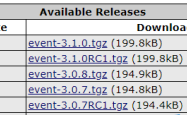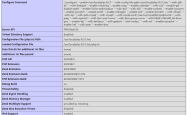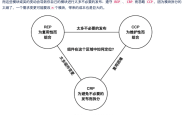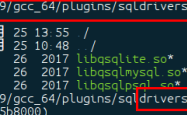Laravel框架数据库迁移操作实例详解
很多人可能在学习Laravel框架的时候,对Laravel的数据库迁移(以下简称Migrations)存在着疑惑:
1. 什么是 Migrations?
2. 为什么要用 Migrations?
3. Migrations 到底方便在哪里?
好了,抱着这些问题,我们今天就一起来学习Migrations。
什么是 Migrations?
我们先来看一下Laravel官方文档怎么写的:
Migrations are like version control for your database, allowing your team to easily modify and share the application's database schema. Migrations are typically paired with Laravel's schema builder to easily build your application's database schema. If you have ever had to tell a teammate to manually add a column to their local database schema, you've faced the problem that database migrations solve.
简单概括起来,就是我们可以将Migrations看作一种数据库的VCS(Version Control System),即版本控制系统。
可以通过Laravel的artisan命令快速创建、修改或还原数据库结构。
为什么要用 Migrations?
使用Migrations可以有效地对数据库进行版本控制,并且遵从了Single Responsibility Principle(单一职责原则),更加方便数据库的操控。
举个例子来说,假设我们已经设计并创建好了数据库,数据已经填充进数据库了,现在我们发现需要在其中一张表里增加一个名为name的栏目(column),需要在另一张表中将author栏目的名字改为user,那么我现在进入数据库里,进行了操作。刚刚操作完,公司老板突然找我面谈。面谈完了之后,我忘记了将我在数据库里的操作记录下来或者告知给其他开发人员,那么随之而来的很可能是灾难性的结果。
如果我们使用了Migrations,并且只通过Migrations进行数据库的操作,那么所有开发人员都可以看到数据库进行了哪些操作,而不会发生上述的情况。
Migrations 到底方便在哪里?
除了上述提到的版本控制功能外,我们几乎不需要写SQL代码就能简单快速地组建起数据库结构,并且可以迅速迁移(migrate)或者回滚(Rollback),省去了大量人工操作的繁琐。
讲解完了概念,我们现在来看一下具体怎么使用Migrations。
要创建一个迁移文件,我们可以用以下artisan命令:
?| 1 | $ php artisan make :migration create_samples_table --create=samples |
注意php artisan命令需要在项目根目录下运行。--create==samples这个选项表明我们想要建立一个名为samples的数据库表,所以artisan会自动在database\migrations目录下建立一个叫2017_03_13_061422_create_samples_table.php的文件(其中前缀是创建该文件的日期和时间,用于区分迁移文件的时间先后顺序),并且会自动填充好Schema::create这个方法,方便我们创建更多的column:
?| 1 2 3 4 5 6 7 8 9 10 11 12 13 14 15 16 17 18 19 20 21 22 23 24 25 26 27 28 29 30 31 | <?php use Illuminate\Support\Facades\Schema; use Illuminate\Database\Schema\Blueprint; use Illuminate\Database\Migrations\Migration; class CreateSamplesTable extends Migration { /** * Run the migrations. * * @return void */ public function up() { Schema::create( 'samples' , function (Blueprint $table ) { $table ->increments( 'id' ); $table ->timestamps(); }); } /** * Reverse the migrations. * * @return void */ public function down() { Schema::dropIfExists( 'samples' ); } } |
我们看到,这个类中有up和down两个方法。up中我们需要添加创建数据表的函数,以及添加各个栏目的名称及属性。而down方法中我们需要添加在回滚该迁移文件时应该有什么样的结果(这里我们直接删除这张表)。
可以看出,up和down中的操作是对应的,在up中进行了什么操作,down中就需要撤销这些操作。
现在我们详细来看一下up方法。我们看到,Schema::create这个方法是用来创建我们数据表的,在方法中,我们看到Laravel已经为我们填充了几个columns。
$table->increments('id')将创建一个名为id的column,并赋予PRIMARY KEY、UNSIGNED及AUTO INCREMENT属性。
$table->timestamps()将创建created_at和updated_at两个column(类型是DATETIME)。
注意:Laravel默认认为每个table都会存在一个id栏目,并且要求每个table都要有created_at和updated_at这两个栏目。
现在,我们要在samples表里增加一个名为name的VARCHAR类型的栏目,该怎么做呢?
很简单,只需要加上这行:
$table->string('name');
如果我们想限制VARCHAR的长度,可以在第二个参数中进行注明:
$table->string('name', 100);
好了,我们暂时就只需要这些栏目。现在我们已经有了迁移文件了,怎么样才能在数据库里建立起我们的表呢?
很简单,输入
?| 1 | $ php artisan migrate |
等待命令完成就可以了。
现在我们在数据库里,就能看到我们的samples表了。
注意:运行php artisan migrate之前请检查你的.env文件中DB_DATABASE,DB_USERNAME,DB_PASSWORD 几项配置是否正确。如果你在Homestead下进行Laravel开发,那么DB_USERNAME默认为homestead,DB_PASSWORD默认为secret,DB_DATABASE请根据你的项目具体填入你的数据库名称。
现在问题来了,我们突然想在samples表里,添加一个名为url的栏目,该怎么做呢?我们分情况讨论。
1. 我们处于本地开发阶段,数据使用种子(Seed)文件进行填充。
对于本地开发,如果想省事,可以直接在samples表的迁移文件中,添加上我们需要的栏目:
?| 1 | $table ->string( 'url' , 200)->nullable(); |
然后我们重置数据库并做种:
?| 1 | $ php artisan migrate:refresh --seed |
这样就完成了。打开samples表,我们会发现新的栏目已经被创建。
注意,php artisan migrate:refresh命令相当于
?| 1 2 3 | $ php artisan migrate:reset $ php artisan migrate |
所以我们经常会使用到。
2. 另一种情况,我们需要详细记录每一个数据库操作,例如在production环境下进行数据库修改。
首先我们需要添加一个package:
?| 1 | $ composer require doctrine /dbal |
要进行表的修改必须添加以上包裹。
完成后我们需要创建一个新的迁移文件:
?| 1 | $ php artisan make :migration add_url_field_to_samples_table --table=samples |
我们想要添加一个url栏目,并且让它在name之后,我们在Schema::table函数中填入以下代码:
?| 1 2 3 4 5 6 7 8 9 10 11 12 13 14 15 16 17 18 19 20 21 22 23 24 25 26 27 28 29 30 31 32 | <?php use Illuminate\Support\Facades\Schema; use Illuminate\Database\Schema\Blueprint; use Illuminate\Database\Migrations\Migration; class ModifySamplesTable extends Migration { /** * Run the migrations. * * @return void */ public function up() { Schema::table( 'samples' , function (Blueprint $table ) { $table ->string( 'url' , 200)->after( 'name' ); }); } /** * Reverse the migrations. * * @return void */ public function down() { Schema::table( 'samples' , function (Blueprint $table ) { $table ->dropColumn( 'url' ); }); } } |
完成后,我们运行migrate:
?| 1 | $ php artisan migrate |
这样,url就被添加进了sample表中,并且位置处于name之后。
我们在samples表中插入了新的url栏目,那么现在如果我们想把name这个栏目长度限制从100修改为50,该怎么做呢?
同理,我们需要先创建一个migration:
?| 1 | $ php artisan make :migration modify_name_column_in_samples_table --table=samples |
在migration文件中,我们添加以下代码:
?| 1 2 3 4 5 6 7 8 9 10 11 12 13 14 15 16 17 18 19 20 21 22 23 24 25 26 27 28 29 30 31 32 | <?php use Illuminate\Support\Facades\Schema; use Illuminate\Database\Schema\Blueprint; use Illuminate\Database\Migrations\Migration; class ModifyNameColumnInSamplesTable extends Migration { /** * Run the migrations. * * @return void */ public function up() { Schema::table( 'samples' , function (Blueprint $table ) { $table ->string( 'name' , 50)->change(); }); } /** * Reverse the migrations. * * @return void */ public function down() { Schema::table( 'samples' , function (Blueprint $table ) { $table ->string( 'name' , 100)->change(); }); } } |
完成后,我们再次运行migrate:
?| 1 | $ php artisan migrate |
这样一来就完成了栏目的修改,非常的直观。
注意:如果我们想把某个栏目改成其他类型,可以采用以下语法
$table->text('name')->change();
完成之后,再次运行php artisan migrate,我们就可以看到name已经从VARCHAR变为了TEXT类型了。
好了,本文主要讲解了Laravel框架中数据库迁移操作的方法实例,更多关于Laravel框架的使用技巧请查看下面的相关链接
原文链接:https://blog.sbot.io/articles/12
1.本站遵循行业规范,任何转载的稿件都会明确标注作者和来源;2.本站的原创文章,请转载时务必注明文章作者和来源,不尊重原创的行为我们将追究责任;3.作者投稿可能会经我们编辑修改或补充。










